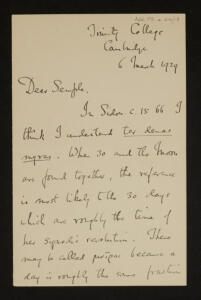Identity area
Reference code
Title
Date(s)
- 6 Mar. 1929 (Creation)
Level of description
Extent and medium
1 folded sheet, 1 envelope
Context area
Name of creator
Repository
Archival history
Immediate source of acquisition or transfer
Content and structure area
Scope and content
(With envelope.)
—————
Transcript
Trinity College | Cambridge
6 March 1929
Dear Semple,
In Sidon. c. 15 66 I think I understand ter denas myras. When 30 and the Moon are found together, the reference is most likely to the 30 days which are roughly the time of her synodic revolution. These may be called μοῖραι because a day is roughly the same fraction of the year that a degree is of the zodiac, 1/360; and while the Moon is passing her 30 days the Sun is traversing 30 degrees of the ecliptic.
For tropico climate (if it is not mere surplusage and applicable to all the planets alike) I can only think of an explanation uncomplimentary to Sidonius. Saturn’s sphere, the outermost of the seven, was cold, as in the passages I cite at Luc. X 205–9 {1}; Sidonius’ phrase in 61, ire per summa polorum, may indicate that he thought the orbit of Saturn passed somehow through the two poles; and, if so, he may here be putting the Moon’s orbit in the tropics merely because her sphere is the innermost, without reflecting that the Sun’s orbit (not to speak of the other planets) must also be there.
prope may be taken locally, as you suggest, the Moon being προσγειοτάτη πάντων τῶν ἄστρων {2}, or it may modify ter denas, the exact time being rather less than 30 days.
Yours sincerely
A. E. Housman.
[Direction on envelope:] W. H. Semple Esq. | The University | Reading
—————
The envelope, which bears a 1½d. stamp, was postmarked at Cambridge at 10.45 p.m. on 6 Mar.
{1} M. Annaei Lucani Belli civilis libri decem, ed. Housman (1926).
{2} Cleomedes, Caelestia (Κυκλικὴ θεωρία μετεώρων), I. 3. 30.

